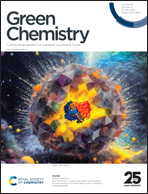Nature's empowerment: unraveling superior performance and green degradation closed-loop in self-curing fully bio-based benzoxazines†
Abstract
Benzoxazines, renowned for their self-curing properties, high glass transition temperature, and exceptional thermal stability, have faced environmental and biotoxicity concerns despite their remarkable performance. Combining high-performance, ecofriendly and degradable benzoxazines remains a challenge. In this work, we synthesized an entirely bio-based benzoxazine resin, 2,6-bis(3-(furan-2-ylmethyl)-8-methoxy-2-phenyl-3,4-dihydro-2H-benzo[e][1,3]oxazin-6-yl)tetrahydro-[1,3]dioxino[5,4-d][1,3]dioxine (VE-BZ), from natural raw materials, including vanillin, erythritol, furfurylamine, and natural benzaldehyde. The presence of the bis(acetal) structure, furanic structure, and benzene ring-branched chain structure in the resin confers favorable adhesive strength, high carbon residue, self-extinguishing ability, and outstanding thermal stability to VE-BZ. Moreover, VE-BZ can undergo dual-site curing and complete degradation through the synergistic effects of acid and heat, enabling its reuse in benzoxazine synthesis. The acid used for both synthesis and degradation is bio-based citric acid, eliminating non-biobased catalysts or additives from the entire process. This approach embodies a comprehensive green chemistry closed-loop process. In essence, this research offers valuable perspectives on seamlessly combining exceptional performance with eco-friendly attributes in the realm of benzoxazine resin materials.



 Please wait while we load your content...
Please wait while we load your content...